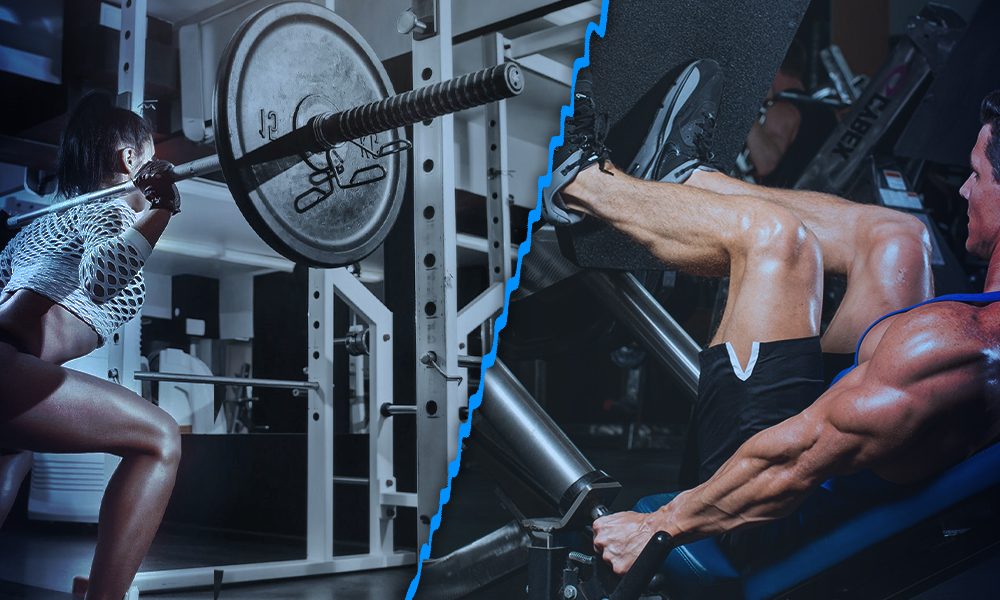
Low Carb Vs Low Fat – Dissecting the Diets
Many people approach weight loss by going low carb because they believe carbs are the evil culprit for storing unwanted blubber around their waist.

Weights vs machines is a face palm worthy debate, especially when you see dorks claim free weights are better and manlier.
Most people arguing in these debates simply don’t get nuance and I don’t blame them cause it’s easier to say real men squat and sissies use the smith machine than it is to understand muscle growth science.
But if you’re willing to learn, let me red pill you into some exercise selection basics.
Muscle growth ultimately comes down to how much mechanical tension you can impose on the muscle. All your muscles care about is mechanical tension. It has no idea how much weight you’re using nor does it care. It merely registers mechanical tension regardless if that tension comes from a barbell, dumbbell, cable, or machine.
And just as a reminder, mechanical tension is not synonymous with load. The heavier exercise doesn’t always build more muscle.
For example, barbell bench pressing grows the triceps less than overhead rope extensions. Sumo deadlifts also grows the hamstrings less than Romanian deadlifts.
Because research finds mechanical tension can be the same between machines and free weights despite the disparity in load (1,2).
However, research often looks at averages from all sorts of machines, weights, body parts, and human anatomical differences.
It lacks nuance. So sure, you can use weights or machines and still build muscle, but you clicked on this article because you want to know which would be better in certain situations.
Because there can be clear winners in many comparisons. For example, one study found barbell curls grew as much muscle as cable curls, but they used a facing in cable curl which defeats the purpose (3). Had they had the lifters face away, the cable curls would’ve likely grown more muscle (4).
Here’s a criteria you can use to determine if a free weight or machine variation is better for a given muscle.

Range of motion is the first factor we must consider because larger ranges of motion for a targeted muscle grow more muscle especially if that range of motion can add tension to the lengthened position. As I’ve discussed before, the lengthened (also called stretched) position is more anabolic than the shortened position.
So when comparing weights vs machines, you need to ask yourself does this machine limit or add contractile range of motion compared to a free weight variation?
For example, barbell back squats are an extremely popular exercise for the quads yet it often has less range of motion than a hack squat.
Because of the biomechanics of a barbell squat, it forces the lifter to have a certain level of mobility to go all the way down without compromising spine/hip position. In addition, even if you can go all the way down, to keep the barbell up over your center of mass, some people don’t have the ideal limb ratios to get enough knee flexion (knee bend).
This means that even if you can barbell back squat all the way down, your anatomy isn’t maximizing your quad range of motion.
This is one of the main reasons why a hack squat, leg press, pendulum squat, and smith machine all grow more muscle than a barbell back squat. Their design is more favorable for larger quad contracting ranges of motion.
However, while machines can add range of motion, they can also limit it as well because no 2 machines are the same, not to mention people have different anatomical structures.
For instance, short lifters (especially if they have longer arms) doing a shoulder press machine at the highest seat setting can still have a compromised range of motion. Anyone who fits this description knows what I’m talking about.
The pressing range of motion might end just above her ear, but with a dumbbell shoulder press, they can get a fuller range of motion.
Short people can also have their range of motion cut short on poorly designed 45 degree hip extensions and other machines.
Furthermore, let’s look at the barbell hip thrust vs a smith machine hip thrust. Because hip thrusting is naturally an arc range of motion. The fixed path of the smith machine especially if it’s a purely vertical one, actually limits your range of motion.
The point I’m getting at is there are lots of range of motion nuances when comparing weights vs machines. And this is only 1 of many factors you need to consider.
This factor will generally favor machines. Here’s why. Weights challenge your muscles in only one direction which is down. Thanks gravity.
However, the beauty of machines is their design can move the line of force to better challenge your muscles which not only trains certain muscles better, but trains them across the range of motion more comprehensively.
For example, cable rope extensions and db kickbacks have the same range of motion. However, the dumbbells only resist down, so as you get closer to the top of the kickback, your triceps receive tons of resistance, but gets practically no tension from midway down.
Same goes for dumbbell lateral raises and dumbbell leg curls. You’ll notice, there’s a portion of the range of motion that’s easy where mechanical tension is minimal. A cable or machine version beats a dumbbell every single day of the week here because you get a better line of force to provide more resistance across the same range of motion.
Now comes one of the most interesting and important factors to consider which is the factor of stability. Machines often get a bad rep because they have a more fixed path and “don’t work your stabilizers” as much. But this is often exactly why machines are so useful.
In any given exercise, it doesn’t matter how many muscles are involved. Only the prime movers (muscles most responsible for moving the load) grow because they’re the only ones producing substantial force to move the load by changing lengths and thus, experience mechanical tension.
Synergists (supporting muscles that barely activate) and stabilizers (muscles only designed to stabilize) don’t grow even if they’re more involved in an exercise (5).
So when using free weights, the need for stability produces these effects.
This is not to say using free weights or stability intensive exercises (like unstable surfaces or loads) are useless. They can help you build strength in those exercises because strength gain is always specific to the conditions trained (11). In fact, exercises requiring more stability can have more neural adaptations making the strength a little bit more transferable than something like machine training.
However, I would argue given the choice between a little bit more neural adaption (skill improvement) vs morphological adaptations (muscles looking bigger and hotter), most people would choose the latter.
So if growing a specific muscle maximally is your goal for a particular exercise, machines are often the better choice because lower stability demands means more mechanical tension on the targeted muscles while involving fewer other muscles to minimize fatigue.
One study highlights this well. It found smith machine squats grows slightly more muscle than barbell squats which grows more muscle than wobble board squats despite all 3 conditions being matched for range of motion (13).
In most comparisons, the free weights have to prove themselves to be comparable to a machine or cable. If you’re triggered at this point, ask yourself why you have an emotional attachment towards free weights.
Believe it or not, most machines grow a bit more muscle than free weights because they have a better stimulus to fatigue ratio. Free weights are still great, but they can be limiting if big juicy muscles is the main goal.
At the end of the day, both can work fine. Neither class of free weights or machines is always better. If the getting more growth is important for you, save this article and keep learning to compare exercises on a case by case basis.
1. PD;, Schwanbeck. “Effects of Training with Free Weights versus Machines on Muscle Mass, Strength, Free Testosterone, and Free Cortisol Levels.” Journal of Strength and Conditioning Research, U.S. National Library of Medicine, https://pubmed.ncbi.nlm.nih.gov/32358310/.
2. SJ;, Heidel. “Machines and Free Weight Exercises: A Systematic Review and Meta-Analysis Comparing Changes in Muscle Size, Strength, and Power.” The Journal of Sports Medicine and Physical Fitness, U.S. National Library of Medicine, https://pubmed.ncbi.nlm.nih.gov/34609100/.
3. Nunes, João Pedro, et al. “Placing Greater Torque at Shorter or Longer Muscle Lengths? Effects of Cable vs. Barbell Preacher Curl Training on Muscular Strength and Hypertrophy in Young Adults.” MDPI, Multidisciplinary Digital Publishing Institute, 13 Aug. 2020, https://www.mdpi.com/1660-4601/17/16/5859/htm.
4. Nunes. “Placing Greater Torque at Shorter or Longer Muscle Lengths? Effects of Cable vs. Barbell Preacher Curl Training on Muscular Strength and Hypertrophy in Young Adults.” International Journal of Environmental Research and Public Health, U.S. National Library of Medicine, https://pubmed.ncbi.nlm.nih.gov/32823490/.
5. Sangwan, Sangeeta, et al. “Characteristics of Stabilizer Muscles: A Systematic Review.” Physiotherapy Canada. Physiotherapie Canada, University of Toronto Press Incorporated, 2014, https://www.ncbi.nlm.nih.gov/labs/pmc/articles/PMC4403366/.
6. CN;, Bampouras. “Interplay between Body Stabilisation and Quadriceps Muscle Activation Capacity.” Journal of Electromyography and Kinesiology : Official Journal of the International Society of Electrophysiological Kinesiology, U.S. National Library of Medicine, https://pubmed.ncbi.nlm.nih.gov/28395183/.
7. B;, Turpin. “Selective Muscle Contraction during Plantarflexion Is Incompatible with Maximal Voluntary Torque Assessment.” European Journal of Applied Physiology, U.S. National Library of Medicine, https://pubmed.ncbi.nlm.nih.gov/24817384/.
8. MA;, Ostrowski. “Effect of an Unstable Load on Primary and Stabilizing Muscles during the Bench Press.” Journal of Strength and Conditioning Research, U.S. National Library of Medicine, https://pubmed.ncbi.nlm.nih.gov/27564994/.
9. LA;, Lawrence. “Effect of Unstable Loads on Stabilizing Muscles and Bar Motion during the Bench Press.” Journal of Strength and Conditioning Research, U.S. National Library of Medicine, https://pubmed.ncbi.nlm.nih.gov/30138240/.
10. WC;, Kohler. “Muscle Activation Patterns While Lifting Stable and Unstable Loads on Stable and Unstable Surfaces.” Journal of Strength and Conditioning Research, U.S. National Library of Medicine, https://pubmed.ncbi.nlm.nih.gov/20072068/.
11. Cacchio. “Effects of 8-Week Strength Training with Two Models of Chest Press Machines on Muscular Activity Pattern and Strength.” Journal of Electromyography and Kinesiology : Official Journal of the International Society of Electrophysiological Kinesiology, U.S. National Library of Medicine, https://pubmed.ncbi.nlm.nih.gov/17329124/.
Grab my free checklist on how to defeat your worst food cravings

Many people approach weight loss by going low carb because they believe carbs are the evil culprit for storing unwanted blubber around their waist.

Diet breaks and refeeds are overrated. I know I’ll offend lots of people and frankly, I don’t give a flying fairy about it.

Here’s How Often You Should Take Desk Breaks Many of us sit daily inside a car or an office for hours upon end. I bet